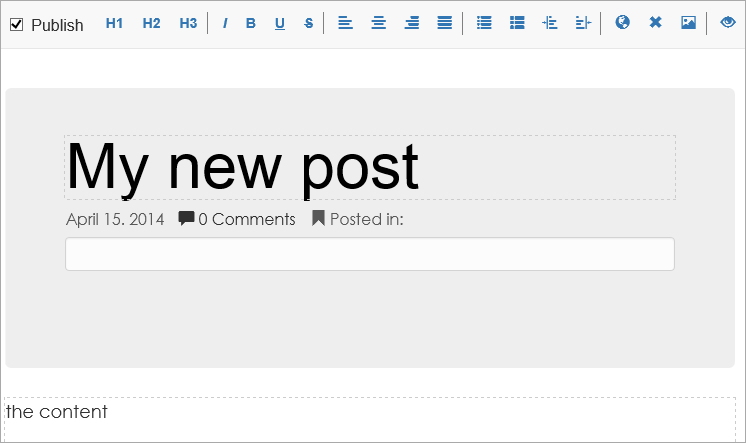Windows Phone 8.1 has my attention now

I've had an iPhone since the 3GS (I have a 5S right now) but I'm always flirting with the Windows Phone. It's just prettier than my iPhone, but my iPhone has a lot of apps...so I stay with it. Folks tease me at work and at conferences for not using a Windows Phone. I always say "when it's an awesome phone platform, I'll use it."
Man, Windows Phone 8.1 is definitely more than "point 1 better." Seriously.
It's the platform Windows Phone should have been from the beginning. From a general functionality perspective, this 8.1 update brings the Windows Phone (finally) on par with my iPhone 5s, and in some cases, takes it beyond. It's REALLY tempting now.
There's a lot of new stuff, but a few things really grabbed my attention that my iPhone doesn't have yet:
- Notification Center - Finally. Swipe down from the top and get notifications in one place. Just like an iPhone you get quick access buttons for airplane mode, wireless, etc. Even better, those buttons are configurable. I added Internet Sharing to mine. You can also swipe down then press Settings as a fast way to get to the main settings page.
- Transparent Live Tiles - You can use a background image for your whole start screen, and it will show through transparent tiles. It also has a nice parallax effect when scrolling. Check it out in the video below.
- "Show more Tiles" on smaller resolution devices - The 1520 on the right has the 1080p screen, while the 920 is a lower resolution screen. Previously only high-res screens got the extra column of tiles. Now smaller screen devices can choose their start screen size and add LOTS more info to a single screen.
- Pinnable Website Tiles - This one surprised me. I recently added support to my blog for IE11 Pinned Tiles, so you can pin this website to your start screen and get an updated Live Tile showing the latest stories. I talked to the front end developer at The Verge and he added the feature for theverge.com as well. His implementation is REALLY impressive. The surprise was that Windows Phone 8.1 now supports that same technique and I didn't need to do anything. See on the 920 on the right, at the bottom, that's a pinned flipped tile showing a story from my blog. Very nice.
- Cortana Voice Assistant - You could say this is the Windows' Siri, but it's more like Google Now with a personality. The voice recognition happens as you speak as opposed to after the fact, which is nice. You can ask questions like "How old is Oprah" and she (or he) just knows. You can say "Call my wife" and she'll say "Who is your wife?" then associate a contact with that nomenclature.
- Quiet Hours - I use Do Not Disturb on my iPhone. Quiet Hours takes this a little further with the concept of an "Inner Circle" and a more sophisticated series of configurable rules like "Don't bother me at night on weekdays unless it's these three people, and text everyone else back that I'm not answering calls."
- Driving Mode - This was added in a Windows Phone 8 update but I love it. It knows you're driving because you associate your cars' Bluetooth with it, then it will text folks "I'm driving, I'll get back to you" if they text you. You can choose to never see the text until you stop. Very cool.
- Keyboard Swiping - It's built into the main keyboard now, no separate app. The predictive text has gotten better as well.
- Battery Sense - The phone can tell you what apps are eating the battery, and when they are eating it. It'll show if the battery is being used by apps in the background or in the foreground.
I recorded a video on a real phone (the 1520 above, in fact) and demonstrated a LOT of the new feature. Check it out as part of my Windows 8 YouTube video playlist, or embedded below. I used the Project My Screen app (MSI) and turned it on in Settings on the phone, connected with USB.
If you have a Windows Phone 8 now and want to get the preview of Windows Phone 8.1:
- Go register free at http://appstudio.windowsphone.com.
- Then go to "Windows Phone Preview for Developers" and install the "Preview for Developers" app.
- Go to Settings, then System Update and update your phone. Depending on how up-to-date your phone is, this might take 2-3 visits. One of my phone needed just one update, another needed 3. It'll take 10-15 min.
If you get the Preview today,your phone will update to the final version automatically, I'm told. Go check it out!
Related Links
- From Concept to Code in 6 hours: Shipping my first Windows Phone App
- Updating my Windows Phone App to Windows Phone 8
- Trying a Nokia Lumia 1020 - A Camera with a Phone Inside
- "I can't even think about switching phones without these apps." Windows Phone 7, a Nokia Lumia 800 and the Essential Apps
Sponsor: Big thanks to Red Gate for sponsoring the feed this week. 24% of database devs don’t use source control. Do you? Database source control is now standard. SQL Source Control is an easy way to start - it links your database to any source control system. Try it free!
About Scott
Scott Hanselman is a former professor, former Chief Architect in finance, now speaker, consultant, father, diabetic, and Microsoft employee. He is a failed stand-up comic, a cornrower, and a book author.
About Newsletter






